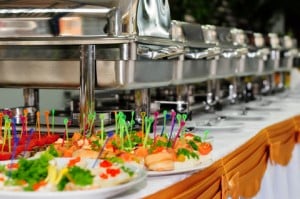 With wedding season in full swing, many catering companies and facilities that offer refreshments will find themselves booked through the summer. Food safety is important during preparation and presentation in any catering situation. Using extra care in small areas can be the difference between a mostly-safe catered event and a perfectly-executed one.
With wedding season in full swing, many catering companies and facilities that offer refreshments will find themselves booked through the summer. Food safety is important during preparation and presentation in any catering situation. Using extra care in small areas can be the difference between a mostly-safe catered event and a perfectly-executed one.
Below, we’ve rounded up 5 tips to make sure your catering season is safe and successful.
1. Be sure that all workers are washing their hands regularly and wearing safety gloves for culinary work.
Washing hands is a no-brainer and is likely something you require your workers to do multiple times during a shift. It’s certainly not to be taken lightly: according to the Centers for Disease Control (CDC), a whopping 89% of foodborne illness is a result of contamination by food workers.
Workers should wash their hands before handling food or utensils in the kitchen. It is also wise to wash hands before touching anything that will be in a serving area. If gloves are used, hands should be washed before donning gloves. If a worker touches their hair or skin, such as their face, they should remove their gloves (if they are wearing them) and wash their hands again.
2. Watch out for cross-contamination during preparation and serving periods.
Cross-contamination is another big area that can cause illness in food preparation. Remind staff members who are working with meat to wash their hands before handling other foods and to clean their workspace with disinfectant before bringing in new food.
All utensils should be thoroughly washed and not used between food types. For example, knives used to cut fruits or vegetables should not also be used with meats. Knives used for cutting meat should not be rotated between different kinds of meats, such as between chicken and beef. For every new meat item, a new utensil should be used.
To properly clean and sanitize kitchen utensils and food preparation areas, use a all-purpose cleaner with disinfectant, such as Worldwide Janitor’s All-Purpose Neutral Cleaner. All foods should also be separated carefully during preparation, delivery, and presentation.
3. Consider how long cold food will be displayed before it is consumed.
Keeping foods that are intended to be cold at the appropriate temperature can be a challenge, especially if you are catering an outdoor summer event. In order to keep items consistently cooled, pre-cool the display holder when possible. Display a small amount of the cooled food at a time and refresh quantities more often. This will keep the chilled foods displayed for the shortest time possible before they’re consumed by guests.
4. Be mindful of how long hot items could sit unattended.
In a buffet setting, hot foods are often something that receives less attention. Unlike cold foods, they generally don’t require any extra care and are fine to sit in their serving dishes without being often tended to.
Still, it is important to consider how long items will be sitting in their serving dishes. As with cold foods, hot foods should be prepared and displayed as needed. It is unwise to over-prepare and display a large amount of hot food that isn’t likely to be eaten in a short period.
When displaying hot foods in buffet settings, be sure that you are mindful of the amount in the display. Use portable heat sources responsibly and appropriately, such as Worldwide Janitor’s Steam Power Heat or our Safe Heat Power Wick Fuel under chafing dishes. Of course, when using anything with an open flame, be sure nothing flammable is nearby.
5. Be aware of what foods need special care.
Certain foods, such as eggs, shellfish, and rice, have delicate preparation and serving needs. If you are preparing these foods before an event, be sure to cool and store them adequately.
Eggs are famous for being pesky carriers of salmonella. Be sure that any eggs used are cooked thoroughly before serving. Eggs should always be used within their “best by” or “use before” dates. Never take chances – if the date has passed, the eggs are no longer suitable to use.
Shellfish can be a lovely addition to any event. Preparation for these items should come from someone who is trained to handle them. Any opened or damaged shells among mussels or clams should be thrown out. (After cooking, most shells will open. It is important to be sure shells are not open prior to preparation.) When preparing shrimp or scallops, be sure the food’s color has changed all the way through the items. There should be no remaining translucent areas.
Rice should be kept hot up until the moment it is served unless prepared ahead. Never prepare rice and allow it to sit unheated or unattended for a long length of time. Rice can be dangerous when left at room temperature. To store cooked rice to be used later, cool it down and store it as quickly as possible.
By following these procedures, your next catered event will be a positive experience for you and your client. Giving just a small amount of extra attention in a few areas will set your catering business apart from your competitors. Your business will thrive because you care.





